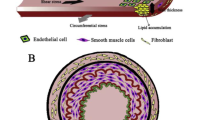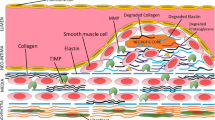Abstract
The vascular extracellular matrix is responsible for the mechanical properties of the vessel wall and is also involved in biologic processes such as cellular adhesion, regulation, and proliferation. Thus, an adequate balance of its components is necessary for the normal functioning of the vasculature. Vascular disorders affect this balance, and this plays a key role in their pathophysiology. Atherogenesis is accompanied by an increase in matrix deposition in response to low-density lipoprotein accumulation. However, this matrix, mainly collagen, also has a protective role by forming a fibrous cap around the lipid core, avoiding contact with blood. A decrease in the amount of collagen will weaken the cap and make it prone to rupture, leading to thrombosis and acute coronary syndromes. In hypertension, the increase in matrix deposition results in vascular stiffness and cardiac dysfunction. In this paper, we discuss the relevance of matrix regulation in these conditions.
Similar content being viewed by others
References and Recommended Reading
Raghvendra KD, Jackson EK, Rupprecht HD, Sterzel RB: Factors controlling growth and matrix production in vascular smooth muscle and glomerular mesangial cells. Curr Opin Nephrol Hypertens 1997, 6:88–105. Extensive review of the mechanisms that regulate matrix production and cell growth in the vascular and renal systems.
Libby P: Molecular bases of the acute coronary syndromes. Circulation 1995, 91:2844–2850. This article reviews the importance of collagen in plaque stability and discusses the regulation of its synthesis and degradation.
Sukhova GK, Schonbeck U, Rabkin E, et al.: Evidence for increased collagenolysis by interstitial collagenases-1 and -3 in vulnerable human atheromatous plaques. Circulation 1999, 99:2503–2509.
Shah PK, Falk E, Badimon JJ, et al.: Human monocyte-derived macrophages induce collagen breakdown in fibrous caps of atherosclerotic plaques. Potential role of matrix-degrading metalloproteinases and implications for plaque rupture. Circulation 1995, 92:1565–1569.
Aikawa M, Rabkin E, Okada Y, et al.: Lipid lowering by diet reduces matrix metalloproteinase activity and increases collagen content of rabbit atheroma. Circulation 1998, 97:2433–2444. Demonstrates that lipid reduction stabilizes plaques, at least in part, by a decrease in collagen degradation.
Bustos C, Hernández-Presa MA, Ortego M, et al.: HMG-CoA reductase inhibition by atorvastatin reduces neointimal inflammation in a rabbit model of atherosclerosis. J Am Coll Cardiol 1998, 32:2057–2064.
Barnes PJ, Karin M: Nuclear factor-кB. A pivotal transcription factor in chronic inflammatory diseases. N Engl J Med 1997, 336:1066–1071. A didactic and comprehensible review of the regulation and effects of this nuclear factor.
Yokoo T, Kitamura M: Dual regulation of IL-1 beta-mediated matrix metalloproteinase-9 expression in mesangial cells by NF-kappa B and AP-1. Am J Physiol 1996, 270:F123-F130.
Shih PT, Elices MJ, Fang ZT, et al.: Minimally modified low-density lipoprotein induces monocyte adhesion to endothelial connecting segment-1 by activating beta1 integrin. J Clin Invest 1999, 103:613–625.
Wesley RB, Meng X, Godin D, Galis ZS: Extracellular matrix modulates macrophage functions characteristic to atheroma: collagen type I enhances acquisition of resident macrophage traits by human peripheral blood monocytes in vitro. Arterioscler Thromb Vasc Biol 1998, 18:432–440.
Weitkamp B, Cullen P, Plenz G, et al.: Human macrophages synthesize type VIII collagen in vitro and in the atherosclerotic plaque. FASEB J 1999,13:1445–1457.
Fitzsimmons C, Proudfoot D, Bowyer DE: Monocyte prostaglandins inhibit procollagen secretion by human vascular smooth muscle cells: implications for plaque stability. Atherosclerosis 1999, 142:287–293.
Bachem MG, Wendelin D, Schneiderhan W, et al.: Depending on their concentration oxidized low density lipoproteins stimulate extracellular matrix synthesis or induce apoptosis in human coronary artery smooth muscle cells. Clin Chem Lab Med 1999, 37:319–326.
Matsubara H: Pathophysiological role of angiotensin II type 2 receptor in cardiovascular and renal diseases. Circ Res 1998, 83:1182–1191.
Ruiz-Ortega M, Gómez-Garre D, Alcazar R, et al.: Involvement of angiotensin II and endothelin on matrix protein production and renal sclerosis. J Hypertens 1994, 12:S51-S58.
Egido J: Vasoactive hormones and renal sclerosis (Nephrology Forum). Kidney Int 1996, 49:578–597. This review discusses the role of angiotensin II and endothelin in the regulation of mesangial and smooth muscle cell growth.
Hsueh WA, Do YS, Anderson PW, Law RE: Angiotensin II in cell growth and matrix production. Adv Exp Med Biol 1995, 377:217–223.
Border WA, Ruoslahti E: Transforming growth factor b in disease: The dark side of tissue repair. J Clin Invest 1992, 90:1–7.
Ruiz-Ortega M, González S, Seron D, et al.: ACE inhibition reduces proteinuria, glomerular lesions and extracellular matrix production in a normotensive rat model of immune complex nephritis. Kidney Int 1995, 48:1778–1791.
Naftilan AJ, Pratt RE, Dzau VJ: Induction of platelet-derived growth factor A-chain and c-myc gene expressions by angiotensin II in cultured rat vascular smooth muscle cells. J Clin Invest 1989, 83:1419–1424.
Gibbons GH, Pratt RE, Dzau VJ: Vascular smooth muscle cell hypertrophy vs hyperplasia. J Clin Invest 1992, 90:456–461.
Sudhir K, Wilson E, Chatterjee K, Ives HE: Mechanical strain and collagen potentiate mitogenic activity of angiotensin II in rat vascular smooth muscle cells. J Clin Invest 1993, 92:3003–3007.
Powell JS, Clozel JP, Müller RKM, et al.: Inhibitors of angiotensin-converting enzyme prevent myointimal proliferation after vascular injury. Science 1989, 245:186–188.
Hernández-Presa M, Bustos C, Ortego M, et al.: Angiotensin converting enzyme inhibition prevents arterial NF-кB activation, MCP-1 expression and macrophage infiltration in a rabbit model of early accelerated atherosclerosis. Circulation 1997, 95:1532–1541.
Hernández-Presa MA, Bustos C, Ortego M, et al.: The ACE inhibitor quinapril reduces the arterial expression of NF-кB dependent proinflammatory factors but not of collagen in a rabbit model of atherosclerosis. Am J Pathol 1998, 153:1825–1837.
The Heart Outcomes Prevention Evaluation Study Investigators. Effects of angiotensin converting enzyme inhibitor, ramipril, on death from cardiovascular causes, myocardial infarction, and stroke in high-risk patients. N Engl J Med 2000, in press.
Oemar BS, Werner A, Garnier JM, et al.: Human connective tissue growth factor is expressed in advanced atherosclerotic lesions. Circulation 1997, 95:831–839.
Hishikawa K, Oemar BS, Tanner FC, et al.: Overexpression o connective tissue growth factor gene induces apoptosis in human aortic smooth muscle cells. Circulation 1999, 100:2108–2112.
Farb A, Burke AP, Tang AL, et al.: Coronary plaque erosion without rupture into a lipid core: a frequent cause of coronary thrombosis in sudden coronary death. Circulation 1996, 93:1354–1363.
Chrysant SG: Vascular remodeling: the role of angiotensinconverting enzyme inhibitors. Am Heart J 1998, 135:S21-S30.
Blacher J, Guerin AP, Pannier B, et al.: Impact of aortic stiffness on survival in end-stage renal disease. Circulation 1999, 99:2434–2439.
Paul M, Wagner J, Dzau VJ: Gene expression of the reninangiotensin system in human tissues. Quantitative analysis by the polymerase chain reaction. J Clin Invest 1993, 91:2058–2064.
McEwan PE, Gray GA, Sherry L, et al.: Differential effects of angiotensin II on cardiac cell proliferation and intramyocardial perivascular fibrosis in vivo. Circulation 1998, 98 2765–2773.
Boffa JJ, Tharaux PL, Placier S, et al.: Angiotensin II activates collagen type I gene in the renal vasculature of transgenic mice during inhibition of nitric oxide synthesis: evidence for an endothelin-mediated mechanism. Circulation 1999, 100:1901–1908.
Funck RC, Wilke A, Rupp H, Brilla CG: Regulation and role of myocardial collagen matrix remodeling in hypertensive heart disease. Adv Exp Med Biol 1997, 432:35–44.
Ruiz-Ortega M, Egido J: Angiotensin II modulates cell growthrelated events and synthesis of matrix proteins in renal interstitial fibroblasts. Kidney Int 1997, 52:1497–1510.
Gómez-Garre D, Ruiz-Ortega M, Ortego M, et al.: Effects and interactions of endothelin-1 and angiotensin II on matrix protein expression and synthesis and mesangial cell growth. Hypertension 1996, 27:885–892.
Ruiz-Ortega M, Lorenzo O, Egido J: Angiotensin III up-regulates genes involved in kidney damage in mesangial cells and renal interstitial fibroblasts. Kidney Int 1998, 68:S41-S45.
Kerins DM, Hao Q, Vaughan DE: Angiotensin induction of PAI-1 expression in endothelial cells is mediated by the hexapeptide angiotensin IV. J Clin Invest 1995, 96:2515–2520.
Brasier AR, Li J: Mechanisms for inducible control of angiotensinogen gene transcription. Hypertension 1996, 27:465–475.
Zimmermann R, Kastens J, Linz W, et al.: Effect of long-term inhibition on myocardial tissue in hypertensive stroke-prone rats. J Mol Cell Cardiol 1999, 31:1447–1456.
Varo N, Etayo JC, Zalba G, et al.: Losartan inhibits the posttranscriptional synthesis of collagen type I and reverses left ventricular fibrosis in spontaneously hypertensive rats. J Hypertens 1999, 17:107–114.
Brown L, Duce B, Miric G, Sernia C: Reversal of cardiac fibrosis in deoxycorticosterone acetate-salt hypertensive rats by inhibition of the renin-angiotensin system. J Am Soc Nephrol 1999, 10(Suppl 1):S143-S148.
Ledingham JM, Laverty R: Renal afferent arteriolar structure in the genetically (GH) hypertensive rat and the ability of losartan and enalapril to cause structural remodeling. J Hypertens 1998, 16:1945–1952.
Pechanova O, Bernatova I, Pelouch V, Simko F: Protein remodeling of the heart in NO-deficient hypertension: the effect of captopril. J Mol Cell Cardiol 1997, 3: 365–3374.
Laviades C, Varo N, Fernández J, et al.: Abnormalities of the extracellular degradation of collagen type I in essential hypertension. Circulation 1998, 98:535–540. Parameters related with collagen degradation in plasma were measured to find that there is an increase in collagen degradation under ACE inhibition. This finding opens the possibility of monitoring ECM regulation.
Dohi Y, Lüscher TF: Endothelin in hypertensive resistance arteries. Intraluminal and extraluminal dysfunction. Hypertension 1991, 543–549.
Chatziantoniou C, Boff JJ, Ardaillou R, Dussaule JC: Nitric oxide inhibition induces early activation of type I collagen gene in renal resistance vessels and glomeruli in transgenic mice. Role of endothelin. J Clin Invest 1998, 101:2780–2789.
Hocher B, George I, Rebstock J, et al.: Endothelin systemdependent cardiac remodeling in renovascular hypertension. Hypertension 1999, 33:816–822.
Lewin ER: Endothelins as cardiovascular peptides. Nephron 1996, 16:246–251.
Gallagher AM, Yu H, Printz MP: Bradykinin-induced reductions in collagen gene expression involve prostacyclin. Hypertension 1998, 32:84–88.
Partovian C, Benetos A, Pommies JP, et al.: Effects of a chronic high-salt diet on large artery structure: role of endogenous bradykinin. Am J Physiol 1998, 274:H1423-H1428.
Benetos A, Levy BI, Lacolley P, et al.: Role of angiotensin II and bradykinin on aortic collagen following converting enzyme inhibition in spontaneously hypertensive rats. Arterioscler Thromb Vasc Biol 1997, 17:3196–3201.
Author information
Authors and Affiliations
Rights and permissions
About this article
Cite this article
Tuñón, J., Ruiz-Ortega, M. & Egido, J. Regulation of matrix proteins and impact on vascular structure. Current Science Inc 2, 106–113 (2000). https://doi.org/10.1007/s11906-000-0067-2
Issue Date:
DOI: https://doi.org/10.1007/s11906-000-0067-2




